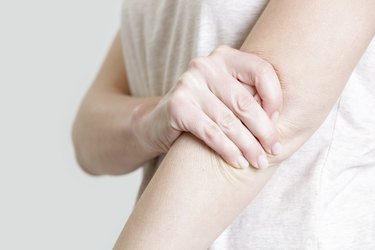
If the tendons on the outside of your elbow hurt, you might have lateral epicondylitis — aka tennis elbow. Although this can result from tennis, you can also get tennis elbow from lifting weights with poor technique, or almost any repetitive movement that involves grabbing or twisting the wrist.
What Is Tennis Elbow?
Video of the Day
As the U.S. National Library of Medicine (NLM) explains, tennis elbow is irritation or even small tears of the tendons along the outside of your upper arm, near the elbow. It may manifest as elbow pain, burning or an ache that lingers and worsens over time. Those sensations may radiate to your forearm and the back of the hand, especially with motions that involve grasping and twisting.
Video of the Day
You might also notice reduced grip strength, or pain when you bend your wrist backward against resistance. Even gentle pressure on the inflamed tendons may cause pain.
There's a reason this type of injury is called tennis elbow. As the University of Colorado Health Center notes, it's typically caused by the force of hitting the ball from the backhand stroke, especially if you have poor technique, weak muscles in your shoulder and wrist, or are using a tennis racket that's too tightly strung or too short.
But you don't have to play tennis to get tennis elbow. As the Mayo Clinic explains, any occupation that involves repetitive wrist and arm motions can overload the tendons in the elbow and lead to the symptoms of tennis elbow. Those include plumbing, painting, carpentry, cooking and repetitive typing or use of a computer mouse.
And as Harvard Health Publishing points out, tendon irritation in general can result from overloading the muscles and tendons. One example of how that happens: increasing your weightlifting load too quickly.
Even if you didn't get tennis elbow from lifting, some types of weight training can make it worse, especially if you don't pay close attention to proper technique. As the University of Rochester Medical Center warns, poor body mechanics during activities like lifting weights, or even something as seemingly simple as painting the ceiling, can contribute to tendon inflammation.
Exercises to Avoid
So, what exercises should you avoid if you have tennis elbow? Start by seeing a medical professional who will diagnose whether tennis elbow is, in fact, the cause of your discomfort. They may do a hands-on exam, X-rays or an MRI.
As the NLM notes, treatment usually begins with two or three weeks of rest for the affected arm, either avoiding or modifying the activities that cause pain. Your doctor can help you narrow down the list of exercises and movements you must avoid, or safe ways to modify them.
The specifics of which exercises aggravate your tennis elbow can vary. But based on the aforementioned expert sources' observations of movements that typically aggravate tennis elbow in particular and tendonitis in general, you may need to avoid some or all of the following:
- Twisting and grabbing motions (e.g., working with dumbbells).
- Gripping anything small (e.g., dumbbells again).
- Forceful and powerful motions (e.g., powerlifting, throwing medicine balls, swinging battle ropes or kettlebells).
- Anything that bends your wrist back against resistance (e.g., any type of press, especially those involving dumbbells or barbells).
Read more: How Do I Work Out With Tendinitis?
Treatments for Tennis Elbow
Aside from the classic RICE (rest, ice, compression, elevate) treatment, your doctor may also recommend training over-the-counter pain medicine and anti-inflammatories. If your tennis elbow was caused by a sports activity or a work activity, you may also need to seek the appropriate help — whether it be from a sports trainer, a manager or your human resources department — to correct the body mechanics that provoked the problem.
You may also need to wear a specially designed brace, receive injections to reduce swelling and pain, or see a physical therapist for a carefully progressed program of stretching and strengthening exercises for your forearms.
You'll start by using very light weights or elastic resistance bands; you might even start with something as simple as extending your fingers against the resistance of a regular rubber band. The American Academy of Orthopaedic Surgeons offers an example of a typical therapeutic exercise program.
If your symptoms haven't improved after six months, the NLM warns that surgery might be a logical next step. However, as noted in a systematic review published in the February 2019 issue of Shoulder and Elbow, the current research evidence suggests that surgery is no more effective for tennis elbow than nonsurgical treatment.
The authors also note that further research is needed in the form of a high-quality, placebo-controlled surgical trial and that there is great room for improvement in the methodology of studies on this subject — so it is possible that future studies will yield different results.
Read more: Treatments for Elbow Pain From Weightlifting
- U.S. National Library of Medicine: "Tennis Elbow"
- University of Colorado Health Center: "Tennis Elbow"
- Shoulder and Elbow: "Surgery for Tennis Elbow: A Systematic Review"
- Mayo Clinic: "Tennis Elbow: Symptoms & Causes"
- Harvard Health Publishing: "Tendonitis"
- University of Rochester Medical Center: "The Best Ways to Treat, Prevent Tendonitis"
- American Academy of Orthopaedic Surgeons: "Therapeutic Exercise Program for Epicondylitis"
Is this an emergency? If you are experiencing serious medical symptoms, please see the National Library of Medicine’s list of signs you need emergency medical attention or call 911.